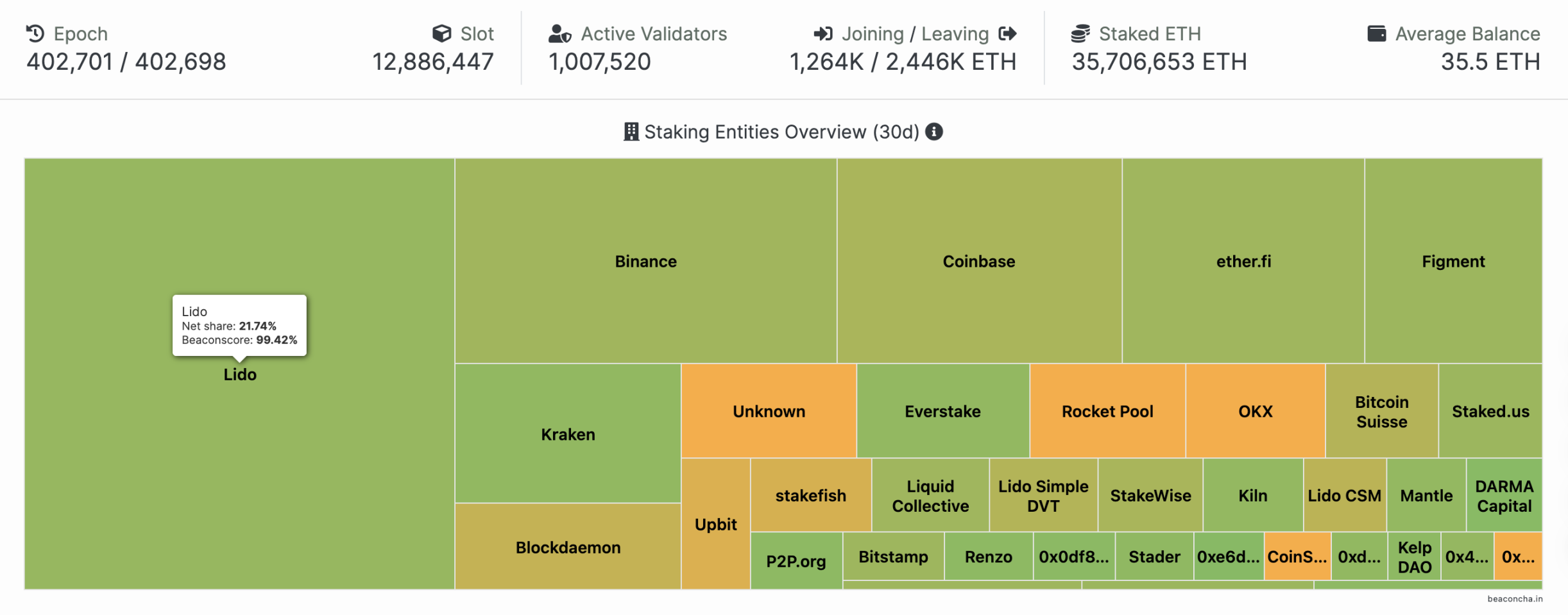Henan's "Old Ties" Hold Up Half the Sky? Ethereum Nodes Revealed
- 核心观点:以太坊节点分布与客户端多元化取得进展。
- 关键要素:
- 质押增速放缓,将达动态平衡。
- 客户端集中度下降,Geth占比51.66%。
- AWS节点占比降至20%,分布更均衡。
- 市场影响:提升网络去中心化与安全性信心。
- 时效性标注:中期影响
Original author: Eric, Foresight News
Before we knew it, the total amount of Ethereum staked has reached approximately 35 million (data statistics vary somewhat between different websites). While it took about a year for this number to grow from 15 million to 25 million, it took twice as long to grow from 25 million to 35 million. It's foreseeable that over time, the amount of Ethereum staked may reach a certain cap, entering a period of dynamic equilibrium between the amount of staked and unstaked.

The above image is from beaconcha.in, an open-source browser developed by BitFly, the developer of EtherMine, once the largest Ethereum PoW mining pool. This Austrian-based Ethereum ecosystem development company has developed several browsers, including ethernodes.org, a data website that provides information about Ethereum's execution and consensus layer nodes. The data previously cited regarding the high number of Ethereum nodes hosted on AWS came from this website.
Two years ago, over 60% of hosted nodes were hosted on AWS. Today, both the node distribution and the cloud providers used have changed significantly. (All data below is current as of the time of writing and excludes unsynchronized nodes.)
Which clients do the nodes use?

Of the 10,475 execution-layer nodes surveyed, Geth accounts for 51.66% of the clients used, still representing an excessively high share. Nethermind, developed by Tomasz Stańczak, the newly appointed Executive Director of the Ethereum Foundation, follows closely behind with a 26.48% share. Besu, originally developed by ConsenSys and later migrated to the Hyperledger Foundation's Github repository in 2019, accounts for 8.26%. Erigon (formerly known as Turbo-Geth, led by British developer Alexey Akhunov and renamed Erigon in May 2021), once considered one of Ethereum's four major execution-layer clients, accounts for 6.1% and has been surpassed by Paradigm's Reth (6.89%).
Reth has been fraught with controversy within the Ethereum community. Yearn core developer Banteg once claimed that Reth borrowed heavily from Akula (a Rust client) and copied the Erigon architecture, but Paradigm did not support these developers. Although Paradigm CTO Georgios Konstantopoulos responded by claiming that Reth "stands on the shoulders of giants," the community disagreed, viewing it as a VC-style resource grab. This incident also led to Akula developers announcing they would no longer maintain the project, believing it could not compete with Paradigm.
Just a week ago, Ethereum core developer Federico Carrone also warned on X that as a for-profit company, Paradigm's expansion (such as recruiting key researchers, funding open source libraries, and leading EIP and Reth) would pose a threat to Ethereum's decentralization, but its dominant Ethrex only accounts for 0.2% of the execution layer clients.
As for consensus layer clients, Lighthouse, founded and maintained by Australian security firm Sigma Prime, holds the highest share of the 8,597 consensus-layer nodes surveyed, accounting for 45.66%. Prysm, with approximately 24%, was originally developed and maintained by blockchain infrastructure company Prysmatic Labs, which was acquired by Arbitrum developer Offchain Labs in 2022. Teku, ranked third with 11.91%, is developed by the same team as Besu. Nimbus, with 10.19%, is a project solely funded by the Ethereum Foundation and other organizations. It aims to improve resource efficiency, enabling node operators to easily run Ethereum client software on resource-constrained devices such as mobile phones and laptops.
In the Ethereum network, the top four execution layer clients and consensus layer clients account for 93.29% and 91.76% respectively, still showing a strong concentration. However, compared with the more exaggerated concentration level two or three years ago, the client diversification promoted by the Ethereum Foundation is still effective.
Where are the nodes?
The location of Ethereum's execution layer nodes and consensus layer nodes is very difficult to accurately identify. The website most likely determines the location through IP analysis, which is not very accurate, but it also gives us a rough outline of the distribution.

Over 30% of the IP addresses of nodes running execution-layer clients are located in the United States, with the highest concentration near Washington, D.C. There are also some nodes in cities like San Francisco, Los Angeles, and New York, with the remaining nodes scattered across Kansas, Iowa, Texas, Florida, and Massachusetts.

As for Europe, the data shows that Germany accounts for 13.13%, the UK accounts for 4.47%, France accounts for 4.28%, and Finland accounts for 3.78%. The map shows that the nodes are generally distributed in the core cities of each country, including Dublin, Ireland, Paris, France, Frankfurt, Germany, and Helsinki, Finland.

Nodes located in China account for less than 4% of all IP addresses, but their distribution is extremely broad, stretching from Changchun, Jilin Province in the north to Hainan in the south, Xining City in Qinghai Province in the west, and east to coastal Shanghai and Taiwan. Notably, based on IP addresses, Hong Kong has 103 nodes, Taiwan has 97, and the rest of China has only 204 nodes in total. The darkest point in the image below is the most concentrated, located in Zhengzhou City, Henan Province.

The distribution of consensus-layer client nodes in North America and Europe is similar to that of execution-layer client nodes. While China still has dozens of nodes in the data, it's not clearly visible on the map. Regarding regional distribution, the United States and Germany rank in the top two for both execution-layer and consensus-layer nodes, but Ethereum nodes are found in nearly every region of the world, including small countries like Guatemala, Kuwait, Montenegro, and even Iceland in the far north.
What cloud services are the nodes using?
"Half of the Ethereum nodes are using AWS" is also a well-known cliché in the industry. Maybe a few years ago, a large number of Ethereum nodes were indeed hosted on cloud services, but this situation has improved greatly now.

Among nodes running execution-layer clients, 49.1% are hosted, while 45% are self-hosted. Consensus-layer client nodes, likely due to the need for stability to prevent penalties, account for 58.5% of hosted nodes, but self-hosted nodes are a close second at 37.5%. Beyond the nature of the nodes, there are many other interesting details within this data.

First, for nodes running execution layer clients, among the Internet service providers that built their own nodes, China Unicom and China Telecom together accounted for 51.52%. In addition, they also included China Unicom Industrial Internet Backbone Network, China Mobile and China Education and Research Computer Network Center, China Unicom (Shenzhen), China Telecom Yunnan Province IDC1 Network, China Telecom Group, Beijing Baidu Netcom Technology Co., Ltd., etc.
This suggests that over 20% of execution-layer client nodes are actually operating in China, but likely using overseas IP addresses. In contrast, very few execution-layer client nodes utilize domestic network operators. Given that operating execution clients offers no stable returns, I speculate that this high percentage primarily serves the needs of RPC nodes, development, on-chain high-frequency trading, or strategy trading, which require rapid transaction broadcasting. This demonstrates that China remains a significant market for on-chain activity.
As for the data on the hosting nodes using various cloud services, it is relatively consistent with the geographical distribution.

Among hosted execution client nodes, 35.53% chose AWS, 13.75% chose German hosting provider Hetzner Online, and 9.69% chose French cloud provider OVHcloud. Google Cloud (7.02%) and Oracle Cloud (2.37%) ranked fourth and fifth, respectively. This aligns with the geographical distribution, which is primarily concentrated in the United States and Europe. Consensus layer client nodes follow a similar pattern, with the aforementioned five providers occupying the top five positions. Alibaba Cloud, Tencent Cloud, and Huawei Cloud also appear on the list, but with very small percentages.
Based on this calculation, the number of nodes hosted on AWS accounts for approximately 20% of the total, which is a reasonable proportion.
Overall, the over 10,000 nodes running execution-layer clients and the nearly 9,000 nodes running consensus-layer clients are not dominated by a single company, regardless of geographic distribution, network services, or hosting providers. The only risk of a dominant player in client selection is a gradual decline in this proportion. The Ethereum Foundation's efforts to promote decentralization are gradually realizing its dream of becoming a "world computer."



